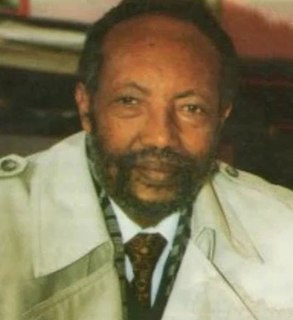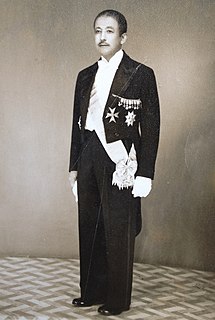
Addis Ababa, also known as Finfinne, is the capital and largest city of Ethiopia. It also serves as regional capital of Oromia. According to the 2007 census, the city's population is estimated at 2,739,551 inhabitants. A highly developed and important cultural, artistic and financial centre, Addis Ababa is a chartered city.

Addis Ababa University (AAU) is a large, highly residential national university in Addis Ababa, Ethiopia. The university is the oldest school of higher education in Ethiopia. AAU has thirteen campuses. Twelve of these are situated in Addis Ababa, and one is located in Bishoftu, about 45 kilometres (28 mi) away. AAU has several associated research institutions including the Institute of Ethiopian Studies. The Ministry of Education admits qualified students to AAU based on their score on the Ethiopian University Entrance Examination (EUEE).

Tsegaye Gabre-Medhin was an Ethiopian poet and novelist. His novels and poets evoke retrospective narratives, fanciful epics, and nationalistic cannonations. Tsegay is considered to be one of the most novelist along with Baalu Girma and Haddis Alemayehu, his books become successful in commercial sales and in even academic thesis. His works solely based in Amharic and English.

Dessie is a town in north-central Ethiopia. Located in the South Wollo Zone of the Amhara Region, it sits at a latitude and longitude of 11°8′N39°38′E, with an elevation between 2,470 and 2,550 metres above sea level. Dessie is 400 km to the north of the capital Addis Ababa. It has a population of more than 200,000 people in over 30 wards.

Afewerk Tekle was an Ethiopian artist, particularly known for his paintings on African and Christian themes as well as his stained glass.
Siltʼe is an Ethiopian Semitic language spoken in central Ethiopia. A member of the Afroasiatic family, its speakers are the Siltʼe, who mainly inhabit the Siltʼe Zone in the Southern Nations, Nationalities, and Peoples' Region. Speakers of the Wolane dialect mainly inhabit the Kokir Gedebano district of Gurage Zone, as well as the neighbouring Seden Sodo district of the Oromia Region. Some have also settled in urban areas in other parts of the country, especially Addis Ababa.

Afäwarq Gäbrä Iyäsus was an Ethiopian writer, who wrote the first novel in Amharic, Ləbb Wälläd Tarik, . Bahru Zewde writes, "Few people before or after him have demonstrated such superb mastery of the Amharic language. Few have ventured with such ingenuity into the hidden recesses of that language to come out with a wealth of vocabulary and idiom one scarcely thought the language possessed. Afäwarq is nonetheless a controversial figure for having supported the Italians during both the First and Second Italo-Ethiopian Wars.

Alemayehu Eshete Andarge was an Ethiopian singer. He had performed since the 1960s and primarily in Amharic. He had been nicknamed "the Ethiopian Elvis".

Aïda Muluneh is an Ethiopian photographer and contemporary artist based in Addis Ababa. She does commercial work as well as photojournalism in Addis Ababa and elsewhere.

Alexander "Skunder" Boghossian was an Ethiopian-Armenian painter and art teacher. He spent much of his life living and working in the United States. He was one of the first, and by far the most acclaimed, contemporary Black artists from the African continent to gain international attention.
The Baháʼí Faith in Ethiopia began after ʻAbdu'l-Bahá wrote letters encouraging taking the religion to Africa in 1916. Probably the first Baháʼí to settle in the country came in early 1934 and with further pioneers by mid-1934, the first Baháʼí Local Spiritual Assembly of the country was elected in November in Addis Ababa. In 1962, Ethiopia Baháʼís had elected a National Spiritual Assembly. By 1963 there were seven localities with smaller groups of Baháʼís in the country. The Association of Religion Data Archives estimated some 27000 Baháʼís in 2005. The community celebrated its diamond jubilee in January 2009.

Getatchew Haile was an Ethiopian-American philologist widely considered the foremost scholar of the Ge'ez language and one of its most prolific. He was acknowledged for his contributions to the field with a MacArthur Fellows Program "genius" award and the Edward Ullendorff Medal from the Council of the British Academy. He was the first Ethiopian and the first African to win the award.

Abe Gubegna was a writer from Ethiopia. His name is sometimes spelled ‘Abbé’ or ‘Abbie’. He published eight novels, five plays, three collections of poetry, and translated several biographies of world leaders as well as other works. Abe mainly wrote in Amharic, but two of his books were written in English.
Zerihun Yetmgeta Yetmgeta is an Ethiopian artist. His paintings and mixed media pieces combine elements of contemporary art with traditional forms of his native Ethiopia, particularly from the icons and scrolls of Ethiopian Orthodox art.

Kebede Mikael was an Ethiopian-born author of both fiction and non-fiction literature. He is widely regarded as one of the most prolific and versatile intellectuals of modern Ethiopia – he was a poet, playwright, essayist, translator, historian, novelist, philosopher, journalist, and government officer belonging to the Shewa Amhara nobility and member of the Solomonic dynasty. He has produced about ninety published works in several languages, some of which have been translated into foreign languages, and have greatly influenced twentieth-century Ethiopian literature and intellectual thought. He has received ample recognition domestically and internationally, including an Honorary Doctorate from Addis Ababa University. He is well known as one of the mid-twentieth-century Japanizing Ethiopian intellectuals.

Yadesa Bojia is a Seattle-based Ethiopian graphic designer and artist. Bojia has exhibited regionally since 2006. In 2010, he rose to international acclaim when his design was selected for the African Union's flag. Bojia has shown his work in exhibitions, completed commissioned works, and given public talks about the themes of his work, including human rights, minority rights, Africa, and justice. Bojia's style as a painter draws on African impressionism.
The Institute of Ethiopian Studies(IES) was officially established in 1963 to collect information on Ethiopian civilization, its history, cultures, and languages. The Institute includes a research and publication unit, a library, and a museum. It is located at Addis Ababa University, Sidist (6) Kilo campus, which was at the time of the IES's opening, named Haile Selassie I University after the last emperor of Abyssinia.
The Skunder Boghossian College of Performing and Visual Arts is the umbrella organization for Ethiopia's oldest secular schools for the arts, offering Bachelors and Masters programs in art, theater, and music.
Daniachew Worku was an Ethiopian writer whose works include novels, plays and short stories. He wrote in both Amharic and English.
Ale Felege Selam Heruy was an Ethiopian painter. He founded the Addis Ababa School of Art in 1957, renamed in his honor to Ale School of Fine Arts and Design.













